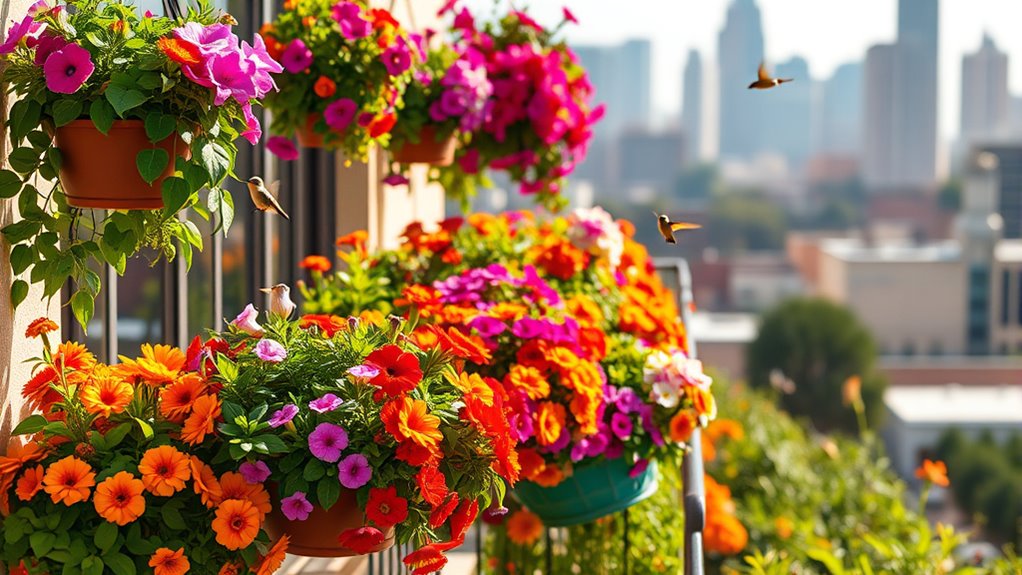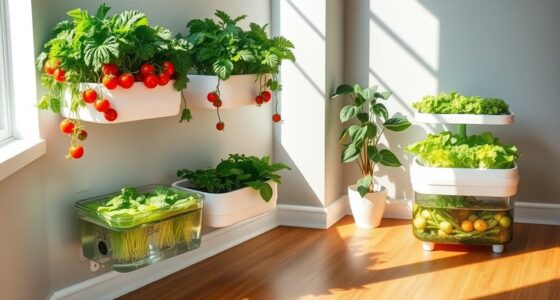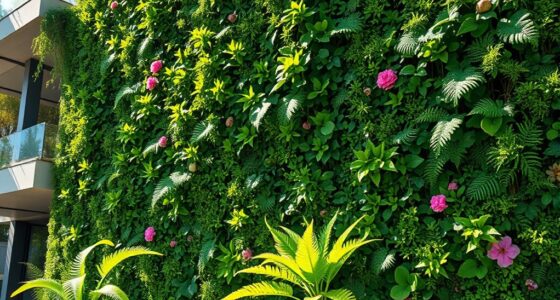To create a pollinator-friendly balcony garden, choose native, nectar-rich plants like Echinacea, Penstemon, and herbs such as lavender or oregano that bloom across seasons. Provide shelter with insect hotels or hollow stems, and guarantee a clean water source with shallow dishes and rocks. Avoid pesticides and maintain regular care through deadheading, watering, and mulching. Incorporate diverse plants and habitats to attract bees and butterflies, and discover more tips to boost your urban pollinator garden.
Key Takeaways
- Use native, nectar-rich plants like Echinacea, Penstemon, and herbs for continuous blooms and pollinator attraction.
- Incorporate shelter options such as insect hotels or hollow stems in sunny, sheltered spots for nesting.
- Ensure regular watering with well-draining soil and add shallow water sources with rocks for pollinator hydration.
- Deadhead flowers and stagger planting schedules to promote reblooming and year-round nectar availability.
- Avoid pesticides, choose organic plants, and group flowering herbs to protect pollinators and enhance garden biodiversity.
Selecting Native and Seasonal Plants for Your Balcony
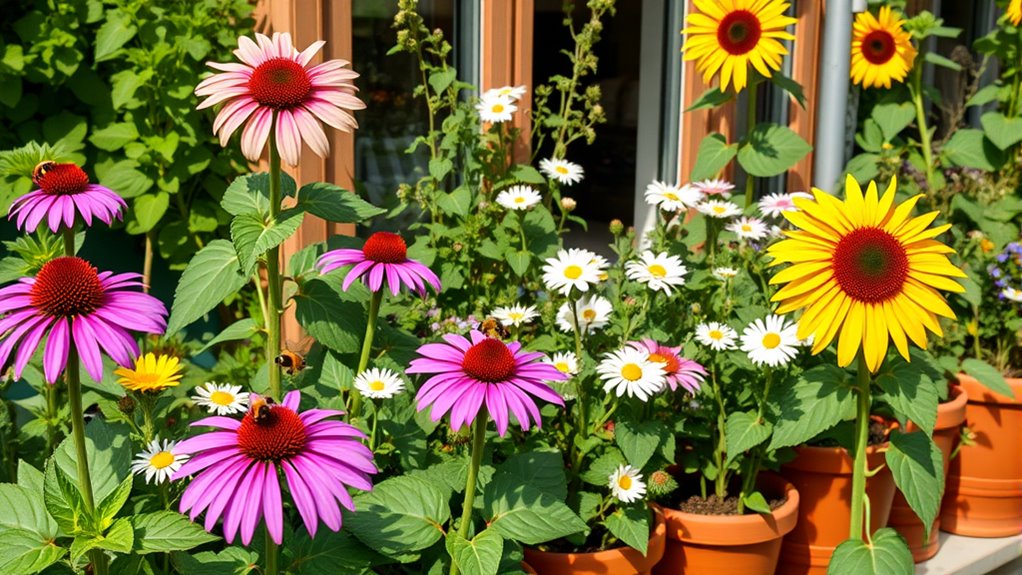
Choosing native and seasonal plants is essential for creating a vibrant, pollinator-friendly balcony garden. Native plants like Echinacea, Penstemon, and Asclepias are well-adapted to your local climate and attract regional pollinators naturally. Incorporate a variety of these plants with different bloom times—spring, summer, and fall—to ensure a continuous nectar supply. Opt for smaller cultivars and perennials suitable for container growth, which promote healthy roots in limited space. Selecting plants with staggered flowering periods keeps pollinator activity steady throughout the year. Prioritize organic, pesticide-free options to protect visiting insects and foster a thriving, balanced ecosystem on your balcony. Additionally, consider integrating native plant decor elements to enhance the garden’s authenticity and support local biodiversity. Creating pollinator habitats such as small bee hotels or nectar-rich feeders can further attract and sustain beneficial insects on your balcony. Incorporating pollinator-friendly gardening practices helps maintain a healthy environment and encourages biodiversity.
Building Shelter and Providing Water for Pollinators
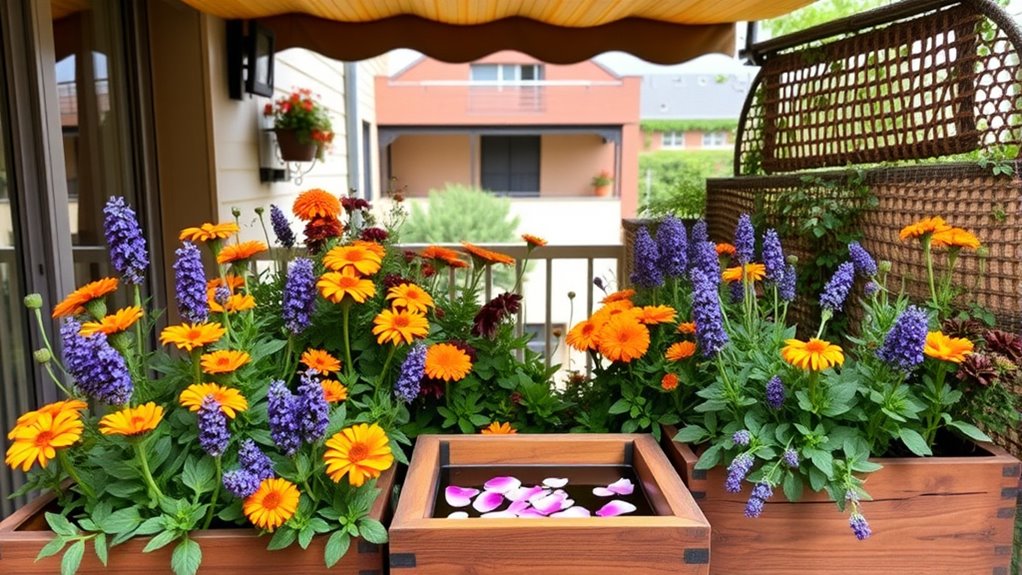
Ever wondered how to make your balcony a safe haven for pollinators? Building shelter with insect hotels or hollow stems gives bee species and other pollinators a secure place to nest. Position these shelters in sunny, sheltered spots with morning sun to attract more visitors and boost nesting success.
Use smooth, closed-back tubes to prevent wing damage and ensure safe nesting. Incorporate native plants nearby, which offer shelter and a continuous source of nectar and pollen, supporting pollinator health and nesting needs. Ensuring proper color accuracy in your garden’s visual cues can also help pollinators locate their preferred plants more easily.
Additionally, providing a clean, accessible water source, like shallow dishes with rocks or terracotta tiles, allows pollinators to drink and regulate their temperature effectively. Maintaining habitat diversity in your balcony garden creates a more resilient environment for pollinators and encourages a thriving, balanced garden. Creating diverse habitats also attracts a wider variety of pollinators, enhancing the overall health of your garden ecosystem. These simple steps transform your balcony into a crucial refuge for pollinators, encouraging a thriving, balanced garden.
Maintaining Your Garden: Deadheading, Watering, and Care Tips
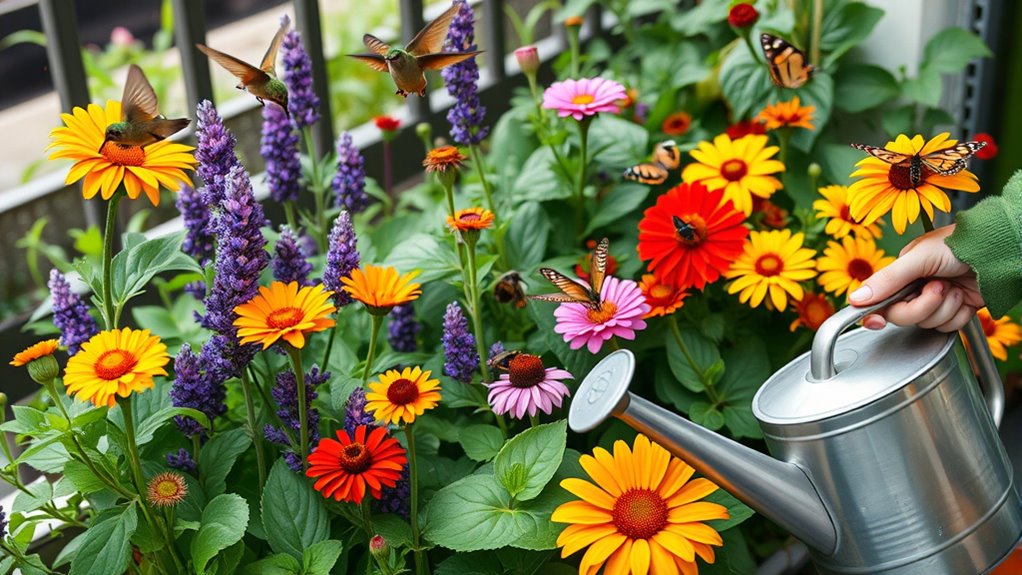
To keep your balcony garden thriving, regular maintenance is vital, including deadheading spent blooms, watering, and monitoring plant health.
Deadheading involves removing faded flowers with sharp shears, which encourages reblooming and extends the flowering period. Proper deadheading techniques can significantly improve the overall appearance and productivity of your pollinator-friendly plants.
Consistent watering is essential; ensure the soil stays moist but not waterlogged, especially during hot or dry spells. Proper watering techniques are crucial for preventing issues like root rot and ensuring plants remain healthy and vigorous. Using appropriate containers with drainage holes helps maintain proper moisture levels and supports healthy root development.
Use large containers with proper drainage to prevent root rot and support healthy growth. Incorporating well-draining soil and choosing frost-proof containers can help protect your plants from temperature fluctuations and extend their lifespan. Additionally, selecting drainage-friendly pots ensures excess water can escape, reducing the risk of overwatering.
Mulching over winter and choosing frost-proof containers protect your plants from cold temperatures and help extend their lifespan. Additionally, applying a layer of mulch can conserve moisture and regulate soil temperature.
Keep a close eye on your plants for signs of drought stress or pests. Regular inspections allow for early intervention and can prevent minor issues from becoming severe.
Adjust your watering and care routines as needed to maintain vibrant, pollinator-friendly blooms and a healthy balcony garden.
Supporting Pollinator Diversity With Herbs and Continuous Blooms
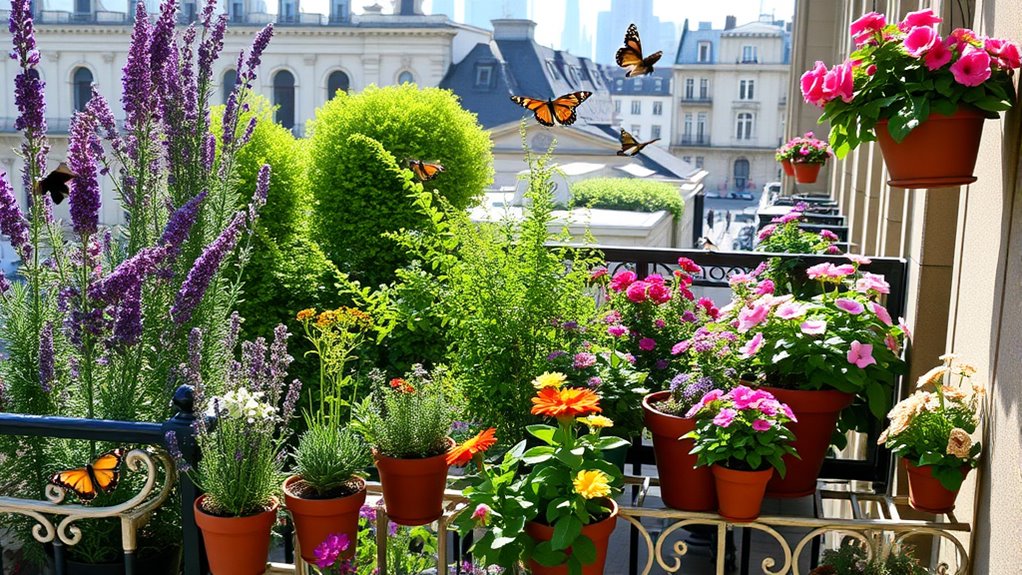
Planting a variety of herbs like lavender, oregano, thyme, and rosemary can considerably boost pollinator activity on your balcony. These herbs attract a range of pollinators, including native plants and wild bees, supporting their populations throughout the season. Incorporating visualization techniques such as creating a visual layout of your garden can enhance your understanding of plant placement and improve pollination success. To maximize their benefits, group herbs in clusters to make it easier for pollinators to find food, increasing visitation rates. Planting a succession of flowering herbs ensures a continuous nectar and pollen supply from spring to fall, supporting diverse pollinator species. Regularly deadheading or harvesting herbs encourages prolonged blooming, maintaining resources for pollinators. Additionally, choosing native plants helps sustain local wild bee populations, making your balcony an essential habitat for urban pollinators. Leveraging pollinator-friendly gardening practices can further attract a variety of beneficial insects to your space. This continuous bloom strategy creates a thriving, pollinator-friendly environment year-round.
Engaging in Small-Scale Actions to Boost Urban Biodiversity
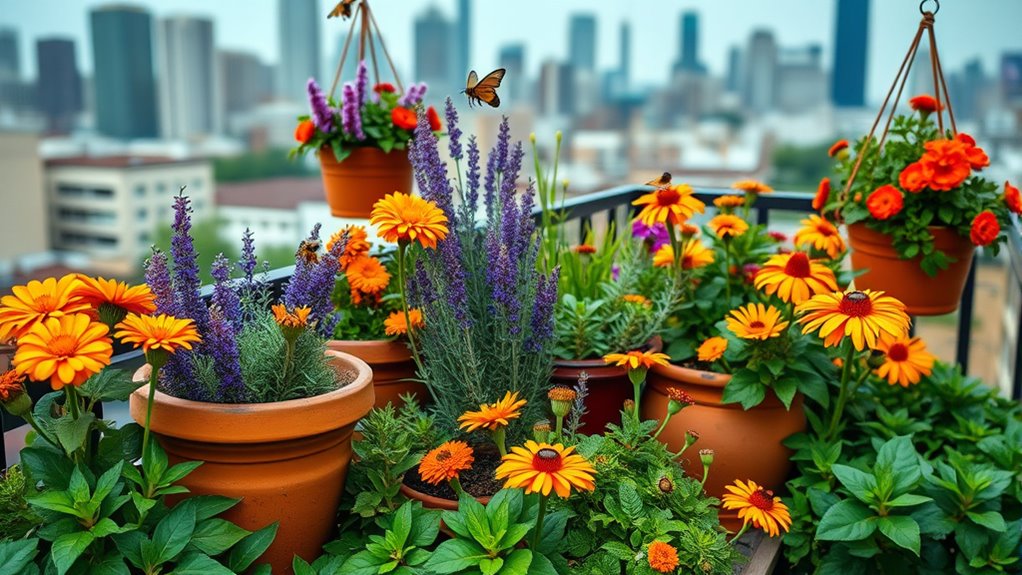
Even small balcony gardens can make a meaningful difference in urban biodiversity by providing habitat and food for pollinators. You can support bees and other pollinators by planting nectar-rich native plants and creating shelter. Building insect hotels and offering clean water sources like bee baths further enhances habitat quality. To guarantee continuous food sources, stagger your planting schedule and include plants that bloom at different times. Avoid pesticides and choose organic, native plants to protect solitary bees and butterflies. Regular maintenance like deadheading and monitoring plant health keeps your garden thriving. Incorporating self watering plant pots can help maintain consistent moisture levels, reducing the need for frequent watering and ensuring your plants stay healthy. Additionally, selecting pollinator-friendly plants that are resilient and adaptable can increase your garden’s success. Here’s a simple way to plan your efforts:
| Action | Benefit | Example |
|---|---|---|
| Plant native, nectar-rich | Supports bees and butterflies | Milkweed, lavender |
| Build insect hotels | Provides shelter for pollinators | Wooden blocks, hollow stems |
| Water sources | Keeps pollinators hydrated | Bee baths, shallow dishes |
| Continuous blooms | Ensures year-round food | Staggered planting schedule |
Frequently Asked Questions
How to Attract Pollinators to a Balcony Garden?
To attract pollinators to your balcony garden, plant a variety of native, nectar-rich flowers that bloom all season long. Include small insect hotels and sheltering plants for nesting.
Avoid pesticides and herbicides so insects stay safe. Provide shallow water sources with stones for drinking.
Maximize sunlight and choose compact plants suited for containers. These steps create an inviting, safe environment that draws pollinators and supports their needs.
Can I Make a Butterfly Garden in an Apartment Balcony?
You can definitely make a butterfly garden on your apartment balcony, and it’s easier than you think. While space might seem limited, choosing compact native plants like coneflowers and lantana in containers creates a vibrant haven.
Add shallow water dishes for butterflies to drink, and skip pesticides to keep them safe. With plenty of sunlight, your balcony transforms into a lively, pollinator-friendly space that attracts butterflies all season long.
How Do I Make My Garden Pollinator Friendly?
To make your garden pollinator-friendly, you should plant a variety of native flowers that bloom at different times, ensuring continuous nectar and pollen. Avoid pesticides, which can harm pollinators, and add features like insect hotels or sheltering plants for nesting.
Use containers with well-draining soil and plenty of sun, and provide a shallow water source with stones for hydration. These steps create a safe, inviting habitat for pollinators.
What Are the Best Pollinator Flowers for Pots?
Think of your balcony as a lively marketplace for pollinators. To attract the busiest visitors, choose native plants like lavender, thyme, and oxeye daisy, which thrive in pots.
Small wildflowers such as Penstemon and Echinacea are perfect because they’re manageable and nectar-rich.
Also, include herbs like rosemary and oregano, with open blooms, to create a continuous, inviting feast that keeps pollinators coming back.
Conclusion
By creating a pollinator-friendly balcony garden, you’re transforming your small space into a buzzing sanctuary that rivals nature itself. With your careful selection of native plants, providing shelter, water, and continuous blooms, you’ll support a vibrant array of pollinators. Every small action you take contributes to a dramatic boost in urban biodiversity—your balcony could become the most lively, colorful haven in the neighborhood. Keep nurturing this tiny paradise, and watch your garden flourish beyond your wildest dreams!
